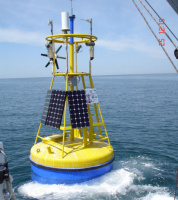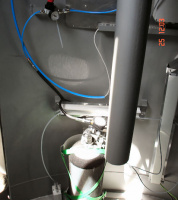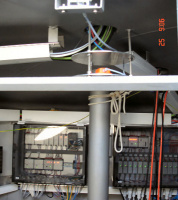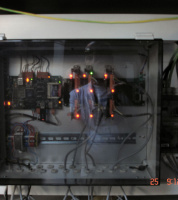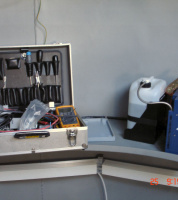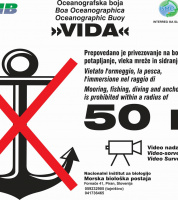A brief description of the coastal oceanographic buoy 'Vida'
Stainless-steel buoy Vida was manufactured and deployed in operation in 2008 by the company Manta d.o.o.. The buoy's hull is made of stainless steal 6 mm thick. It is 2.5 m in diameter and the height of the upper-most sensor (the anemometer) is 5 m. The buoy is fixed with three chains, which are attached to the buoy's hull at points separated by 120 degrees around the hull's perimeter. The chains connect the buoy to three concrete anchors on the seafloor at a depth of 22 m.
On the buoy there are the following instruments:
An acoustic Gill's Instruments 3D anemometer (height 5 m), a Vaisala air temperature and humidity sensor (height 3.5 m), a Seacat of Seabird T and C probe (depth 3 m) with a Wetlab fluorometer for chl-a measurements, an oxygen sensor 'Optode' of Aanderaa, also at a depth of 3 m. An Xsens motion sensor (accelerometer/compass-tilt sensor) is placed in the buoy's hull just below the top-cover of the hull and under the mast. An AWAC current meter from Nortek As is mounted at the seafloor, at a depth of 22 m. There are three surveillance web cameras. One underwater camera is mounted at the bottom of the buoy at about 2 m depth. The buoy is also equipped with three solar panels and a wind generator.
Inside the buoy's hull are the:
- power supply electronics, lead batteries and a fuel cell,
- safety control electronics (sensor to monitor CO2 gas inside the hull, open-hatch IR sensor and three sensors to measure water levels).
- data acquisition electronics
The communication system is an ethernet microwave link, functioning at two frequencies (two transmitters, one at 2.4 GHz, another at 5 GHz). Data are transmitted with a speed of at least 5 Mbit/s.
All connecting cables between the instruments measuring the atmosphere and the electronics are passed through the mast, while cables connecting underwater instruments with the electronics go through a 'pipe' of about 0.3 m in diameter. One end of the pipe penetrates the bottom of the buoy's hull then passes through the top plate of the hull, to a height of about 1 m where it turns down and goes back through the top plate of the hull. In this way the cables enter the buoy's hull from the sea.
The maintanance of the buoy is guaranteed by our collaboration with the Slovenian Environment Agency .
.
For the safety of navigation and the desire to avoid any collision of vessels to the buoy, we give its position: 45° 32.925' N, 13° 33.042' E
 NIB - MORSKA BIOLOŠKA POSTAJA PIRAN
NIB - MORSKA BIOLOŠKA POSTAJA PIRAN

